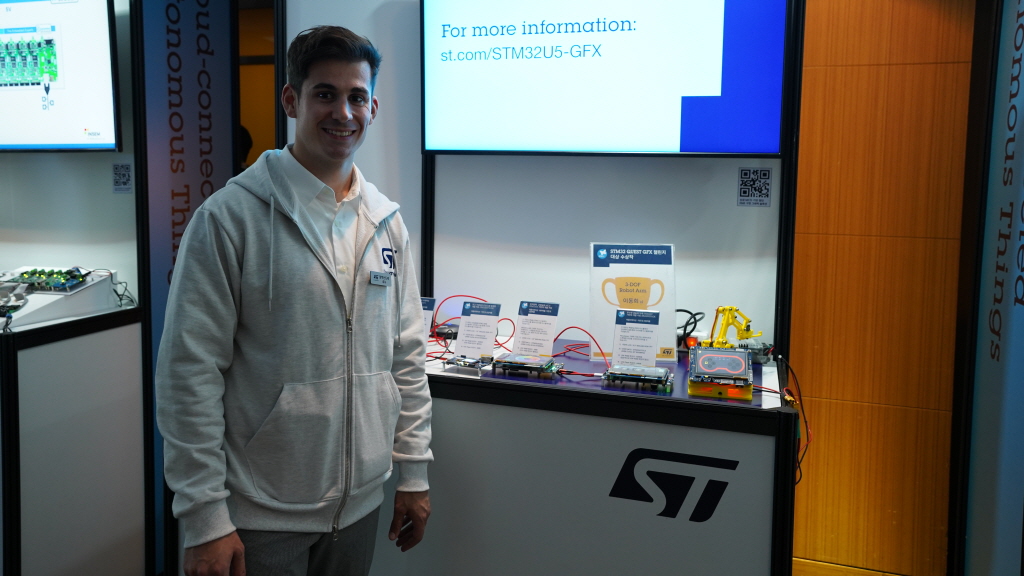본지는 지난 22일 인터컨티넨탈 서울 코엑스에서 개최한 테크 컨퍼런스인 K-TEC에서 ST 알렉산더 르누(Alexandre Renoux) 대리를 만나 TouchGFX에 대해 들어보았다.
“무료 SW 툴 TouchGFX, 고급 HMI 개발 지원”
웨어러블·가전제품 지원 HMI, TouchGFX 사용해 실행 가능
STM32 QUEST GFX 챌린지, “사용성 피드백 참고 기회 작용”
[편집자주] TouchGFX는 STM32 기반 하드웨어용 GUI 애플리케이션을 완벽하게 구현할 수 있게 해주는 소프트웨어 솔루션이다. 이는 그래픽과 관련된 프로젝트 개발을 용이하게 하고, 제한된 하드웨어 성능으로도 고급 UI를 만들 수 있게 최적화된 그래픽 솔루션으로 주목받고 있다. ST마이크로일렉트로닉스(이하 ST)는 TouchGFX를 활용한 챌린지를 열어 홍보 겸 사용성 피드백의 참고 기회로 삼아 편의성과 기술을 발전시키려는 모습도 보이고 있다. 본지는 지난 22일 인터컨티넨탈 서울 코엑스에서 개최한 테크 컨퍼런스인 K-TEC에서 ST 알렉산더 르누(Alexandre Renoux) 대리를 만나 TouchGFX에 대해 들어보았다.

▲ST 알렉산더 르누(Alexandre Renoux) 대리
■ TouchGFX에 대해 소개 부탁드린다
TouchGFX는 ST의 무료 소프트웨어 툴로서, 사용자는 STM32 마이크로컨트롤러의 작은 풋프린트만을 이용해 고급 HMI를 손쉽게 개발할 수 있다.
코드 대부분이 생성되므로 개발자는 프로젝트를 완료하는 데 소요되는 시간을 줄이고 개발 비용도 절감할 수 있다.
■ TouchGFX는 다양한 STM32 MCU에서 지원되는 MCU 기반 GUI 솔루션이다. STM32 MCU 포트폴리오에 대한 설명을 부탁드린다
현재 TouchGFX는 STM32 MCU만 지원하며, 현재 공식적으로 Cortex-M0+, M4, M33 및 M7 MCU를 지원한다.
물론 지원되는 ARM 코어 유형은 시장 수요와 ST가 매년 출시하는 새로운 MCU 제품에 따라 달라진다.
■ TouchGFX가 타깃으로 삼고 있는 애플리케이션은 무엇인가
TouchGFX 및 STM32 MCU는 자동차를 제외한 모든 종류의 애플리케이션을 대상으로 한다.
따라서 웨어러블, 가전제품, 산업, 의료 분야 등을 지원하는 HMI라면 모두 TouchGFX를 사용해 실행할 수 있다.
■ TouchGFX에 대한 시장의 반응은 어떠한가
전반적으로 TouchGFX와 같은 그래픽 솔루션에 대한 시장 수요는 증가하고 있다.
MP1 또는 MP2와 같은 마이크로프로세서에도 TouchGFX를 탑재해 달라는 요청도 자주 받고 있다.
시장은 늘 긍정적인 반응을 보이고 있다.
사용자들은 마이크로컨트롤러를 사용해 간단히 HMI 영역에서 달성할 수 있는 성과들에 대해 깊은 인상을 받았다고 전했다.
MPU + GPU를 사용하는 그래픽 MCU 솔루션을 오해하는 고객들을 자주 접한다.
세계 특정 지역에서는 C++가 잘 숙달되지 않아 UI 개발이 더 어려워진다는 이야기도 간혹 들려오곤 한다.
ST는 최대한 간단하고 강력한 솔루션을 개발하기 위해 노력하지만, 사용자 정의 동작을 위해 C++로 코딩하는 작업은 여전히 필수다.
■ TouchGFX의 가장 큰 차별성과 특장점은 무엇인가
사용자들은 TouchGFX가 사용자 친화적이고 무료로 제공되며 매우 강력한 성능을 갖췄다는 점을 장점으로 언급한다.
STM32 마이크로컨트롤러 내에서 사용할 수 있는 하드웨어 가속기를 활용해 소형 마이크로컨트롤러에서도 60fps를 달성할 수 있다.
그래픽을 라이센스 비용 없이도 구현할 수 있는 솔루션은 TouchGFX가 유일하다.
■ TouchGFX가 최상의 성능을 발휘하는 데 필요한 개발 환경은 무엇인가
16GB RAM, 스토리지용 SSD 외에 상대적으로 최신 프로세서를 갖춘 Windows 컴퓨터를 사용하면 TouchGFX의 최상의 성능을 이끌어낼 수 있다.
■ TouchGFX 최신 버전이 지속적으로 업데이트되고 있다. 가장 최근 업데이트된 기능은 무엇인가
6월에는 4.22 버전이 출시됐고, 다음달인 12월에 4.23 버전이 출시될 예정이다.
이 두 가지 버전에서는 고객이 최종 플랫폼에서 비용을 절약할 수 있도록 플래시 메모리 요구 사항을 줄이는 데 주력했다.
ST는 SVG 이미지, 벡터 글꼴과 같은 벡터 그래픽은 물론 RLE 및 LZW9와 같은 무손실 비트맵 압축을 도입했다.
■ Touch GFX를 바탕으로 하는 STM32 QUEST GFX 챌린지 행사를 열었다고 들었다
STM32 Quest GFX 챌린지는 수년 전부터 진행된 행사로 세 가지 챌린지로 나누어진다.
첫 번째 챌린지는 소프트웨어에 친숙해지는 것, 두 번째는 HMI와의 하드웨어 상호 작용을 이해하는 것이 목표이며, 마지막에는 참가자가 제한된 시간 내에 무엇을 개발할 수 있는지를 확인한다.
■ 이번 행사를 통해 ST가 얻고자 하는 목표는 무엇인가
이 GFX 챌린지의 한결 같은 목표는 ST 그래픽 솔루션을 홍보하고 그 사용성에 대한 피드백을 얻는 것이다.
이를 통해 누가 TouchGFX를 사용하고 있는지, 어떤 이유로 어떤 부분에서 사용자가 어려움을 겪고 있는지를 파악하고 있다.
다른 기술을 소개할 때도 진행할 수 있을 것으로 보고, 이 이벤트를 아시아의 다른 지역까지 확대하는 것을 목표로 하고 있다.
■ 올해 행사를 간단히 요약한다면?
이번 우승자가 3자유도 로봇 팔과 같은 놀라운 프로젝트를 만들어 낸 것에 놀랐다.
총 150명이 행사에 등록해 마지막까지 열정적으로 참여해주었으며, 행사에 대한 사용자들의 많은 관심을 느꼈다.